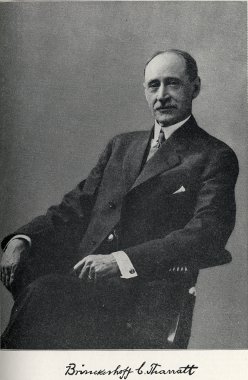Brinckerhoff C. Tharratt had attained the age of eighty-one years when called to his final rest at Boonville, on the 17th of September, 1923. As a citizen and in his social and business relations he belonged to that public-spirited, useful and helpful type of man whose ambitions and desires are centered and directed in those channels through which flows the greatest and most permanent good to the greatest number. He was born in Boonville, Oneida county, on July 23, 1842, a son of Joseph Roger and Margaret (Brinckerhoff) Tharratt. Extended reference to the father is made on another page of this publication.
Spending his youthful days in a home of refinement and culture, Brinckerhoff C. Tharratt was accorded liberal educational opportunities, preparing for college at Whitestown Seminary, but ill health intervened and he was forced to abandon his cherished desire of pursuing a college course. He afterward attended law school in Albany in 1861, completing the course in a year, owing to the fact that he had previously read law in the office and under the direction of Myron D. Faulkner of Boonville. After completing his law course he went to Boone county, Indiana, where he formed a partnership with Judge Dougherty and engaged in the active practice of the law. In 1863 he was commissioned quartermaster and first lieutenant of the One Hundred and Sixteenth Indiana Regiment, by Governor Levi P. Morton. After several attempts had been made to enroll the inhabitants of Worth township, Boone county, Indiana, all of which failed, Mr. Tharratt volunteered to make the attempt. The people were mainly from Kentucky and Tennessee and resisted any effort that was made to force them to identify themselves with the north, but Mr. Tharratt succeeded where others failed, owing to his invincible and determined will to do what he undertook. It was after this that he was made quartermaster and lieutenant and subsequently General J. C. Kise appointed him assistant adjutant general on his staff. He thus served until the close of the war, participating in a number of important engagements, including the battles of Knoxville, Cumberland Gap, Strawberry Plains, Klinch River and others, and with his regiment, the One Hundred and Sixteenth Indiana, he was mustered out in March, 1865.
When the war was over Mr. Tharratt returned to Boonville, where he entered into partnership with H. R. Hadley in the practice of law, but ill health forced him to abandon his profession and later he engaged in mercantile and various other pursuits, notably in furnishing the material for the building of the Mohawk & Malone Railroad. He was also in the coal business as a wholesale dealer in Brooklyn and became one of the extensive landowners of his section of the state, having four hundred acres in a splendid stock farm which he called Elmwood. There he raised thoroughbred Holstein cattle and became recognized as one of the leading stockmen of this section. He was also president of the First National Bank at Boonville and throughout his life in every business venture in which he engaged he pressed steadily forward to the goal of success. He never allowed obstacles or difficulties to bar his path if they could be overcome by persistent and earnest effort.
On the 22d of September, 1864, in Utica, Mr. Tharratt was married to Miss Louise Gilbert, a daughter of John and Sarah Gilbert, natives of Oneida county. The maternal grandfather, Elijah Easton, was a soldier in the War of 1812. They became the parents of two daughters, Jessica Louise and Margaret Josephine, but the latter died on November 2, 1896. The former is the widow of Frederic W. Best, and the mother of a son, Tharratt Gilbert Best, with whom she has traveled extensively in many of the European countries.
Mr. and Mrs. B. C. Tharratt held membership in the Presbyterian church, which had been the faith of the family for many generations. He belonged to Fort Schuyler and Arcanum Clubs and in his political allegiance was a republican. He never cared to hold office himself, though frequently solicited to do so. His advice, however, was often sought and followed in the selection of good men for office and in the adoption of beneficent political measures. Mr. Tharratt took great delight in traveling and not only made extensive trips in this country and visited most of the places of interest in Europe, but spent much time in sightseeing in Mexico. There was probably not a man of large private interests in the community who felt a more hearty concern for the public welfare or was more helpful in bringing about those purifying and wholesome reforms which have been gradually occurring in the political, municipal and social life of the city. The range of his activities and the scope of his influence reached far beyond his business interests, important as they were. His generosity was indicated by the fact that the pension which was his due for his war services, he distributed equally between the Boonville Post of the Grand Army of the Republic and the Women's Relief Corps. He belonged to that class of men who wield a power that is all the more potent from the fact that it is moral rather than political and is exercised for the public weal rather than for personal ends. Those who knew him recognized in him a warm-hearted man of generous, helpful spirit &$8212; charitable, philanthropic and broad-minded — who had extended aid to many and was ever willing to hold out a helping hand to a fellow traveler on life's journey. The following editorial appeared in the Boonville Herald when he passed away:
"Mr. Tharratt will be sincerely mourned by a large acquaintance. He was a broad-minded business man, kind-hearted, and ready to lend a helping hand. His counsel will be greatly missed. Notwithstanding his many and protracted absences from Boonville, he maintained a voting residence here and his interest and civic pride in the village never flagged."
